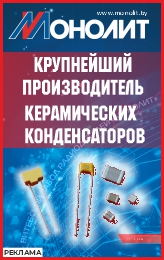Conferences, exhibition & seminars
D. V. Traskovetskaya
IX Congress of the Russian Technology Platform PHOTONICS: the Conference Materials and Components DOI: 10.22184/1993-7296.FRos.2021.15.3.202.212
IX Congress of the Russian Technology Platform PHOTONICS: the Conference Materials and Components DOI: 10.22184/1993-7296.FRos.2021.15.3.202.212
Opto-electronic systems and complexes
A. V. Medvedev, A. V. Grinkevich, S. N. Knyazeva
Night Vision Goggles and Features of Their Use DOI: 10.22184/1993-7296.FRos.2021.15.3.214.226
The article reviews a specific class of optical-electronic devices, which are the night vision goggles. They are not only improving the visibility in various difficult observation conditions but also freeing up the hands of the observer thus enabling various operations during the observation. There are two options of two-channel night vision goggles reviewed in the article featuring IR+TV and TV+SWIR channels, respectively, in terms of the benefits of their operation in the dark.
Night Vision Goggles and Features of Their Use DOI: 10.22184/1993-7296.FRos.2021.15.3.214.226
The article reviews a specific class of optical-electronic devices, which are the night vision goggles. They are not only improving the visibility in various difficult observation conditions but also freeing up the hands of the observer thus enabling various operations during the observation. There are two options of two-channel night vision goggles reviewed in the article featuring IR+TV and TV+SWIR channels, respectively, in terms of the benefits of their operation in the dark.
Tags: cabin equipment ir+tv goggles low-profile goggles night vision goggles swir range swir диапазон внутрикабинное оборудование низкопрофильные очки очки ночного видения тепло-телевизионные очки
Optical Devices & Systems
I. P. Shishkin, A. P. Shkadarevich
Diffraction-Limited Resolution Lenses DOI: 10.22184/1993-7296.FRos.2021.15.3.238.245
There are considered an optical performances of three classical lenses: Gelios, Industar and Tair, which are applicable for modern digital cameras.
Diffraction-Limited Resolution Lenses DOI: 10.22184/1993-7296.FRos.2021.15.3.238.245
There are considered an optical performances of three classical lenses: Gelios, Industar and Tair, which are applicable for modern digital cameras.
Microwave Photonics
A. B. Ustinov, I. Yu. Tatsenko, A. A. Nikitin, A. V. Kondrashov, A. V. Shamray, A. V. Ivanov
Principles of Constructing Optoelectronic Microwave Oscillators DOI: 10.22184/1993-7296.FRos.2021.15.3.228.237
The article confronts the readers with the principles of creating optoelectronic microwave generators. Without pretending to be complete, the authors analyze the main types of generators, classifying them according to their principle of operation. The physical processes underlying the operation of various types of generators are briefly considered. A comparison of the characteristics of the generators is given.
Principles of Constructing Optoelectronic Microwave Oscillators DOI: 10.22184/1993-7296.FRos.2021.15.3.228.237
The article confronts the readers with the principles of creating optoelectronic microwave generators. Without pretending to be complete, the authors analyze the main types of generators, classifying them according to their principle of operation. The physical processes underlying the operation of various types of generators are briefly considered. A comparison of the characteristics of the generators is given.
Tags: integrated ring resonators microwave generator optical frequency comb optoelectronic oscillator интегральные кольцевые резонаторы моды шепчущей галереи оптические частотные гребенки оптоэлектронные генераторы свч-генератор
Fiber Optic Devices & Technoligies
O. V. Burdysheva, E. S. Sholgin, A. Yu. Maksimov
Optimization of the Design of an Experimental Reflective Element for an Amplitude Fiber-Optic Vibration Sensor of a Reflective Type DOI: 10.22184/1993-7296.FRos.2021.15.3.246.260
This work is devoted to the development of a design of a reflective element for an amplitude fiber-optic vibration sensor, as well as testing the performance of such a design. In the presented work, a mathematical model of transverse vibrations is described, which helps to determine the resonance frequencies depending on the length of the free fiber. A reflective surface is implemented, which is a periodic structure of lithium niobate and areas covered with gold. The layout and design of a vibration sensor with the ability to tune the resonance frequency is presented, and an experimental circuit is demonstrated. The signal obtained using the described circuit lends itself to Fourier transform processing, the calculated frequencies coincide with the vibration frequencies of the vibration source. The amplitude-frequency characteristic is obtained, the resonance frequency correlates with the frequencies obtained by the mathematical model (Pearson’s correlation coefficient is 0.977). The results of the implementation of this development are important for a new interdisciplinary direction – agrobiophotonics, provide a key to a more subtle and accurate study of animal vibration sensitivity and plant vibrotropism.
Optimization of the Design of an Experimental Reflective Element for an Amplitude Fiber-Optic Vibration Sensor of a Reflective Type DOI: 10.22184/1993-7296.FRos.2021.15.3.246.260
This work is devoted to the development of a design of a reflective element for an amplitude fiber-optic vibration sensor, as well as testing the performance of such a design. In the presented work, a mathematical model of transverse vibrations is described, which helps to determine the resonance frequencies depending on the length of the free fiber. A reflective surface is implemented, which is a periodic structure of lithium niobate and areas covered with gold. The layout and design of a vibration sensor with the ability to tune the resonance frequency is presented, and an experimental circuit is demonstrated. The signal obtained using the described circuit lends itself to Fourier transform processing, the calculated frequencies coincide with the vibration frequencies of the vibration source. The amplitude-frequency characteristic is obtained, the resonance frequency correlates with the frequencies obtained by the mathematical model (Pearson’s correlation coefficient is 0.977). The results of the implementation of this development are important for a new interdisciplinary direction – agrobiophotonics, provide a key to a more subtle and accurate study of animal vibration sensitivity and plant vibrotropism.
Tags: amplitude reflective type sensor fiber-optic sensor sensor vibration vibration monitoring vibration sensor амплитудный датчик отражательного типа вибрация вибромониторинг волоконно-оптический датчик датчик датчик вибрации
News

 rus
rus TS_pub
TS_pub technospheramag
technospheramag technospheramag
technospheramag ТЕХНОСФЕРА_РИЦ
ТЕХНОСФЕРА_РИЦ


